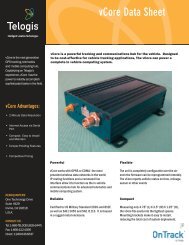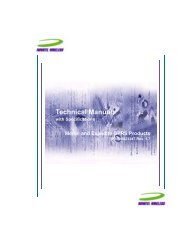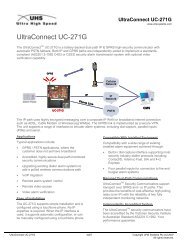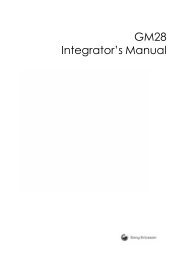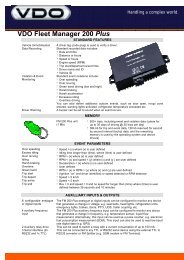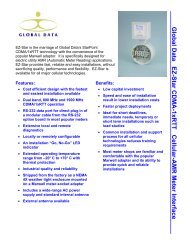Hardware Interface Description - KORE Telematics
Hardware Interface Description - KORE Telematics
Hardware Interface Description - KORE Telematics
You also want an ePaper? Increase the reach of your titles
YUMPU automatically turns print PDFs into web optimized ePapers that Google loves.
XT55/56 <strong>Hardware</strong> <strong>Interface</strong> <strong>Description</strong><br />
Confidential / Released<br />
s<br />
4.3 GPS operating modes<br />
Mode<br />
Normal operation<br />
Trickle Power<br />
mode<br />
Push-to-Fix mode<br />
Function<br />
The receiver is continuously running in Normal mode, as long as the operating<br />
voltage Vcc is supplied. Position fixes are generated at the maximum update<br />
rate. This enables the receiver a warm- and hotstart. However, the cold- and<br />
warmstart times of the receiver do not differ significantly under good visibility<br />
conditions.<br />
Vcc is continuously supplied to the receiver in Trickle Power mode. By using a<br />
especially configurable software, the user can force the receiver to acquire a<br />
position fix periodically. Between two fixes, the receiver will be in a low power<br />
mode.<br />
The power-on scenario in Trickle Power mode on the XT55/56 GPS part differs<br />
from one in continuous mode. If the receiver fails to acquire satellites within a<br />
given period of time (approx. 150 sec), the receiver enters an extended sleep<br />
phase. The duration of this sleep phase is approx. 30 sec. After that, the<br />
receiver wakes up, starts a reset and tries to acquire satellites. This procedure<br />
will be repeated until the GPS receiver can detect satellites. For further details<br />
refer to [1].<br />
In this mode the receiver will turn on every 30 minutes to perform a system<br />
update consisting of a GPS RTC calibration and satellite ephemeris data<br />
collection if required (i.e. a new satellite has become visible) as well as all<br />
software tasks to support SnapSart in the event of an NMI. Ephemeris<br />
collection time in general takes 18 to 30 seconds. If ephemeris data is not<br />
required the system will recalibrate and shut down. In either case, the amount<br />
of time the receiver remains off will be in proportion to how long it stayed on:<br />
Off period = On Period*(1-Duty Cycle)<br />
Duty Cycle<br />
The off period has a possible range between 10 and 7200 seconds. The default<br />
is 1800 seconds.<br />
XT55/56_hd_v02.06a Page 72 of 125 17.12.2004



